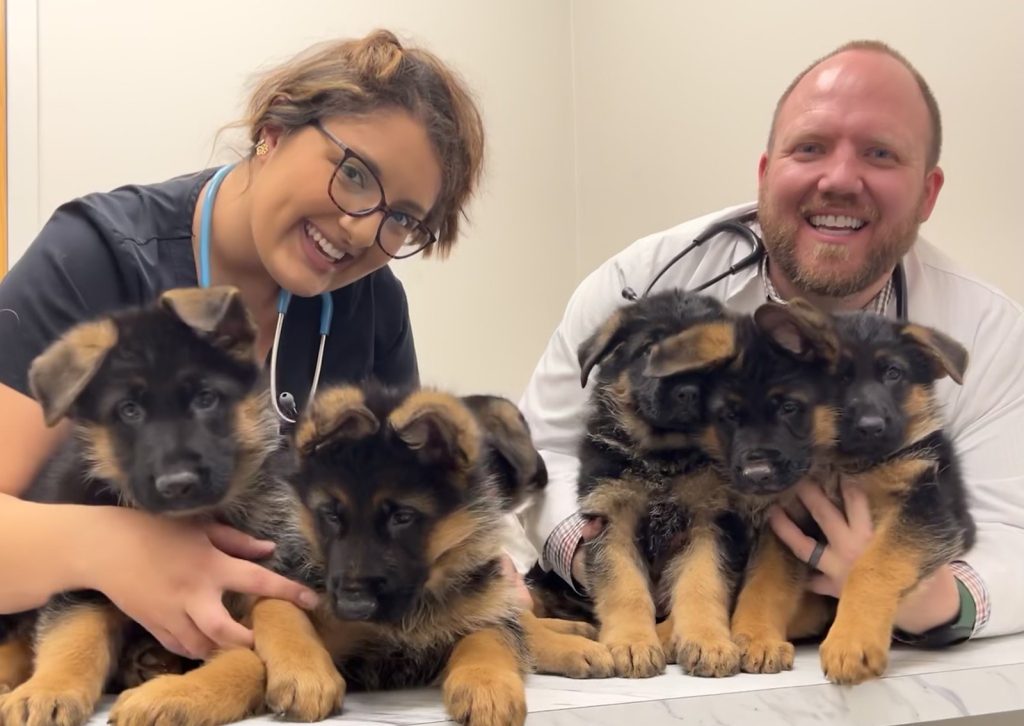15 Things You're Not Sure Of About German Shepherd Life Expectancy
페이지 정보
작성자 Sean 작성일 25-02-12 23:54 조회 9회 댓글 0건본문
 Health Issues That Affect German Shepherd Life Expectancy
Health Issues That Affect German Shepherd Life ExpectancyGerman Shepherds reach their peak between the ages of 2 and 6. The German Shepherd is at its best in terms of physical and mental sharpness.
They are more at risk for cancer, SchäFerhunde suchen ein zuhause (http://www.1moli.Top/) musculoskeletal problems, and other health conditions which can affect their lifespan.
Working line German Shepherds typically have more active lives than their show line counterparts. They need a diet rich in nutrients to support their active lifestyles and exercise.
Cushing's Disease
German Shepherds are susceptible to several health conditions including hip dysplasia and elbow dysplasia. They are also susceptible to Cushing's Disease, degenerative myelopathy and hip dysplasia. Knowing these conditions and taking the correct steps to prevent or treat them can allow your dog to live longer. Regular veterinary visits, good nutrition, and regular exercise are the keys to a healthy and happy large breed.
Cushing's disease (hyperadrenocorticism) occurs when a pet's body produces too much cortisol, a natural steroid. The condition is typically caused by a tumor that has formed on the pituitary gland or one of the adrenal glands. In about 80% to 90% of cases the tumor is located on the pituitary gland which is a pea-sized, sized organ located at the base of the brain. Around 15% of the instances the tumor is located on the adrenal glands that are located above the kidneys.
If a pet suffers from Cushing's, it becomes more active and eats more frequently than usual. The condition also causes increased thirst and urination, so the pet has to drink more fluids and frequent the outside for bathroom breaks. Other signs of the condition include hair loss, a potbellied appearance, and a lack of energy.
A veterinarian can diagnose the disorder by drawing blood and conducting an adrenocorticotropic hormone stimulation test. This test involves injecting ACTH into the patient and then measuring their adrenal response. The results show the degree to which his cortisol levels are.
Once a dog is diagnosed with Cushing's Disease, it is required to take medication for the rest his life. The medication will slow down the growth of the tumor and keep the symptoms under control. If they are monitored properly and medicated, most dogs with this condition can have normal lives. The condition could be fatal when it isn't treated and detected early.
Epilepsy
German Shepherds that are properly diagnosed and reinrassiger deutscher schäFerhund Züchter treated for epilepsy could be healthy and enjoy a happy life. Uncontrolled seizures can cause dogs to die from oxygen deprivation or an injury. Untreated epilepsy can also cause depression, or the inability to eat and drink.
The impact of epilepsy in German Shepherds can be influenced by how the condition is handled by the owner. An owner who can closely check the dog's medication, develop appropriate strategies for managing seizures and establish a solid support system is more likely to extend their pet's life span.
As with all breeds of dog German Shepherds are susceptible to suffering from dental disease. If left untreated, this issue can cause serious damage to gums and teeth and even result in infections in other parts of the body, like the kidneys, liver and the heart. Regular dental visits for dogs can reduce the chance of developing this condition.
Shepherds are at a higher risk of bloat than many other breeds, because of their chests that are narrow and deep. This stomach condition is dangerous and can occur when the intestines twitch and fill with gas, cutting off blood flow to the stomach and the spleen. The condition can be fatal in as little as 30 minutes if it is not treated promptly. If your Shepherd shows signs of bloat, such as retching, heaving, or an enlarged stomach or is in a praying position (front feet are down, the rear is up), you should bring them to an emergency vet as soon as you notice.
German Shepherds with the condition of bloat are more at chance of developing hip dysplasia or degenerative myelopathy. It is crucial to be on top of your dog's veterinary treatment and preventative measures.
Elbow Dysplasia
The elbow is a hinge joint between the humerus (the long bone of the upper forelimb) as well as the radius and ulna (the two bones that make up the lower forelimb). The three bones must fit together in a perfect way to withstand an entire lifetime of motion. If they don't fit together perfectly, elbow dysplasia can occur. It's the most frequent cause of lameness in the front legs (limping) in dogs.
In some cases of the disease, the cartilage between bones begins to degrade, causing pain, swelling, and lameness. This damage is not reversible, so early diagnosis and treatment are important.
The first indications of the disease in a dog are a mild or intermittent limp, particularly after exercise or after getting up from a seated position. As the disease progresses, the dog's range of motion at the elbow decreases, and there may be fluid in the joint.
There are three types of elbow dysplasia. These include: Fragmented Coronoid Process (FCP), Osteochondrosis on the Humeral Condyle (OCH), and Ununited Aconeal Process (UAP). Each of these conditions has a unique appearance on xrays and could be present in both elbows or one of them.
Screening for elbows and hips of breeding animals is currently the best way to prevent these problems. However, despite screenings, these diseases can still be present. Breeding only dogs with elbows that have been proven healthy is the most effective method. This will ensure that the genes for elbow dysplasia are not passed onto offspring.
Degenerative Myelopathy
Degenerative Myelopathy is an autoimmune disorder that affects German Shepherd dogs slowly and causes weakness in the hind legs, Buy German Shepherds is a type of Degenerative Myelopathy. DM symptoms usually appear in older dogs, and can progress to paralysis. It is thought to be the canine equivalent of amyotrophic lateral syndrome (Lou Gehrig's disease). It is unclear the reason why some dogs suffering from this disease develop it and others do not despite having a genetic predisposition.
Unfortunately, there is no cure for DM. The symptoms can be treated by medication, einen deutschen schäferhund kaufen but the condition is progressive and eventually causes paralysis of the forelimbs, too. Certain dogs can last for a number of months or years with a good quality of life. However, [Redirect-302] it's typical for owners to choose the option of euthanasia if their dog is in a position to walk or stand on its own.
Your doctor will conduct an examination of the neurological system and create an extensive medical history to diagnose DM. The neurologist checks for deutscher schäferhund kaufen österreich other diseases that have similar symptoms and will request blood samples to test the genetic mutations that cause with this condition. A sample of cerebrospinal fluid will also be taken to permit analysis and to exclude other diseases. The neurologist may recommend MRI imaging with our advanced diagnostic imaging service. This will allow your vet to identify the regions of the spinal cord affected by DM and monitor progression of the disease over time. Additionally, physical rehabilitation therapy can be beneficial for DM patients and can help slow the progression of the disease.
Intervertebral Disc Disease
German Shepherds can be prone to health issues that could impact their lifespan. Understanding these conditions and how they affect your dog will help you take preventative measures that support their longevity.
Intervertebral Disc Disease occurs when the "doughnut" of the spinal disc does not remain in its proper position. Each disk has an outer fibrous ring called an annulus, and an annulus with a soft nucleus that absorbs impact. When the nucleus gets herniated it can cause severe pain and a paralysis. IVDD is typically an autoimmune process, but sudden trauma can lead to herniation in dogs with weak disks.
Type I of IVDD is associated with the sudden rupture of the disc's nucleus into the spinal canal and results in severe back pain, arching of the back and lower back, weakness in the rear limbs, and hind-limb lameness. It could also be accompanied by incontinence, weakness, and incoordination. If the spinal cord becomes compressed and dies, your dog will become completely paralyzed, deutscher schäFerhund schwarz kaufen and may be being unable to move their rear legs even.
 Type II IVDD is typically seen in older dogs. Normal wear and tear causes the annulus fibers to expand with fluid. This leads to herniation and compression of the spine. This type of IVDD isn't caused either by trauma or vigorous exercise, which is not the case for Type I. The symptoms include a lack of interest or inability to turn the head.
Type II IVDD is typically seen in older dogs. Normal wear and tear causes the annulus fibers to expand with fluid. This leads to herniation and compression of the spine. This type of IVDD isn't caused either by trauma or vigorous exercise, which is not the case for Type I. The symptoms include a lack of interest or inability to turn the head.- 이전글15 Up-And-Coming Buy An Old German Shepherd Dog Bloggers You Need To Be Keeping An Eye On
- 다음글10 Tips To Build Your Buy A German Shepherd Empire
댓글목록
등록된 댓글이 없습니다.


